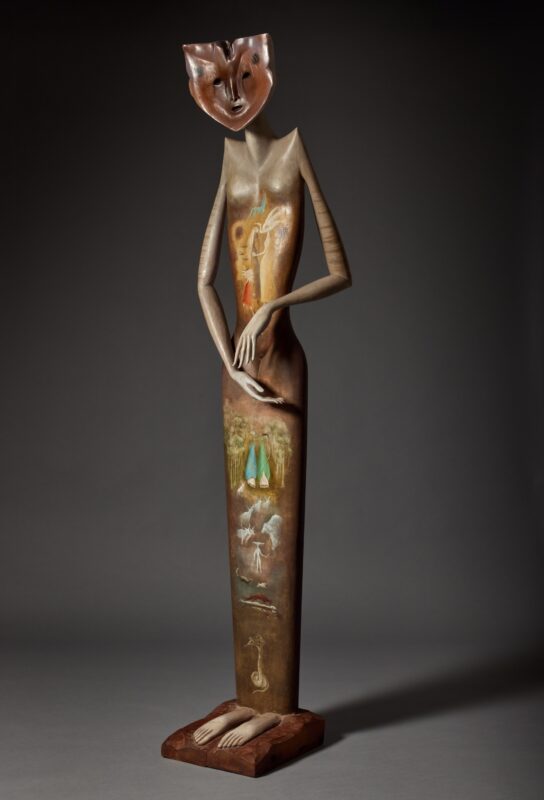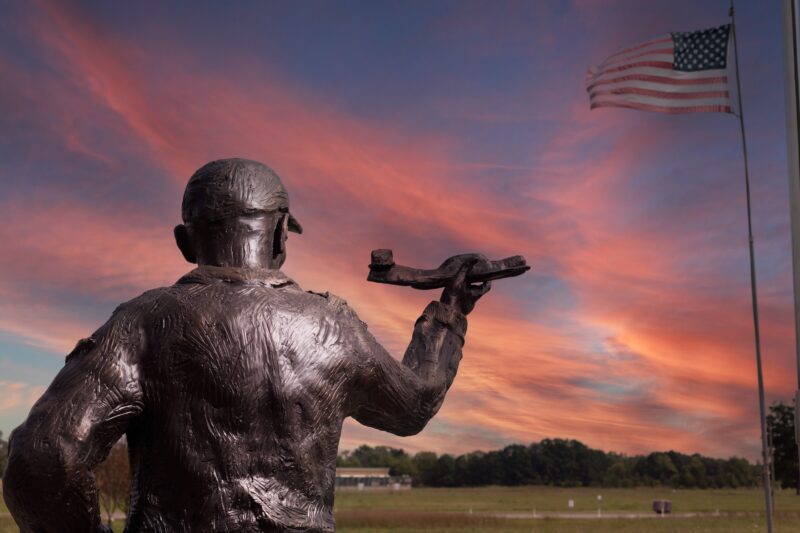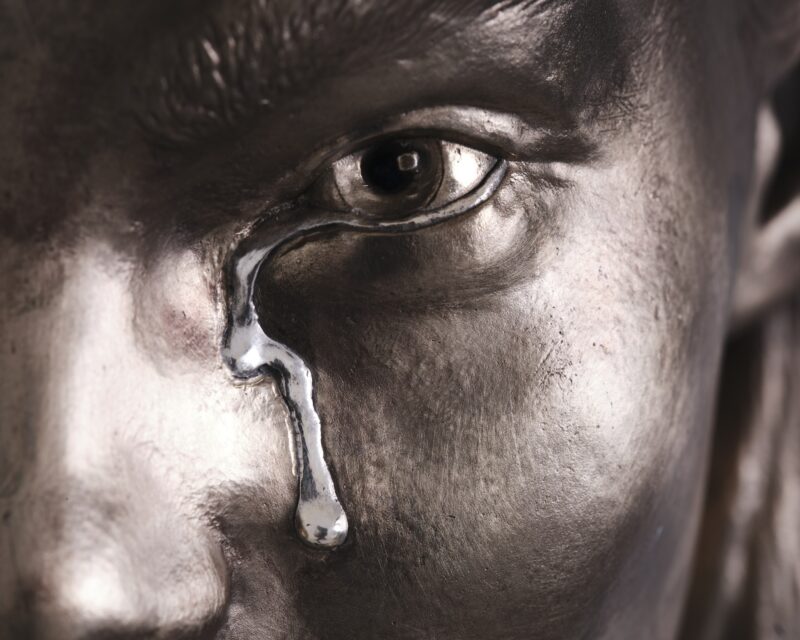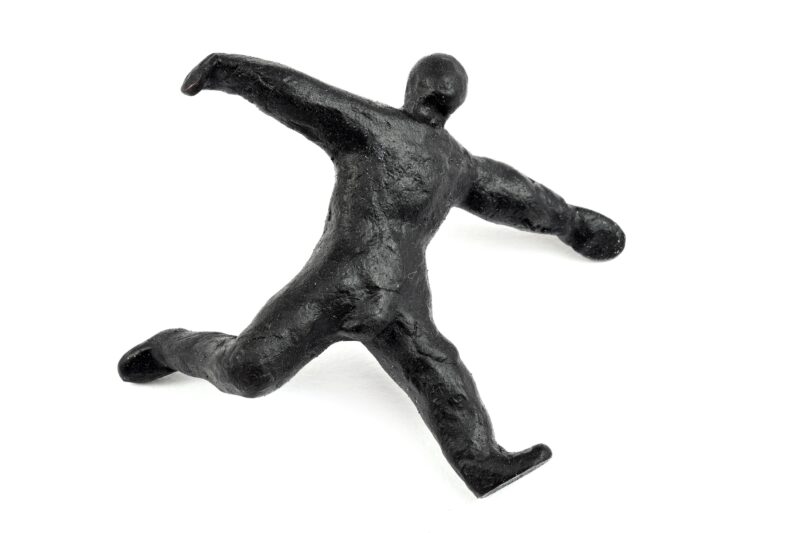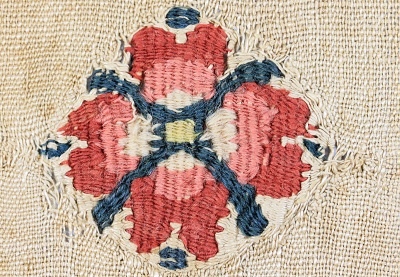
RAVEN ROW Coptic tunic (detail) Egypt, ca. 6th century, wool and linen
CSROT Historic Textile Collection at the Stichting Egress Foundation, Amsterdam
Idris Khan, Manchester
Idris Khan presents a series of haunting ritualised artefacts. He draws cross-associations between sculptural engraving and the traditional observances of the Hajj pilgrimage to Mecca. The Devil’s Wall, a set of three black sculptural monoliths, references a Hajj ritual of throwing seven stones at three walls, each wall standing in for the devil. Similarly, the graphic elaborations in an accompanying set of photographic works refer to minimalist composers Philip Glass and Steve Reich as well as minimalist painters Agnes Martin and Robert Ryman. Khan’s immaculately crafted use of religious, literary and art quotations could seem formulaic, but instead their huge physical presence intrigues, captivates and engrosses.
Whitworth Art Gallery, to 13 May
Robert Clark
The Stuff That Matters, London
Seth Siegelaub is best known as one of conceptual art’s early pioneers. After making his name staging happenings at his New York gallery in the swinging 60s, he collaborated with artists like Joseph Kosuth on game-changing exhibitions in the early-70s. But the curator, dealer and writer has, for the past 30 years, been an avid collector, amassing a vast archive of tapestry, embroidered silks and ancient weaves under the banner Centre For Social Research on Old Textiles. On show for the first time, the treasures include ceremonial headdresses from the Amazon to the Congo, Ming dynasty silks and an Egyptian tunic. Whether as new or frayed, these fabric fragments build a compelling portrait of trade, labour and customs.
Raven Row, E1, Thu to 6 May
Skye Sherwin
Conversations, Dublin
In these days of art exhibitions masquerading as theoretical dissertations, it’s good to get a show like this which just presents a whole range of wonderful stuff almost willy-nilly. Conversations, more than 100 photographs selected from the Bank Of America Collection, includes major works by many of the most charismatic photographers of all time, including Julia Margaret Cameron, Edward Weston and Meridel Rubinstein. The conversations in question are sequences of paired and contrasting images. Then there are photos such as Bernd & Hilla Becher’s that just stop you in your tracks by doing what photography has always done best: revealing the everyday to be far more surreal than the surreal.
Irish Museum Of Modern Art, to 20 May
RC
Weighted Words, London
Tall tales, political protest and manic gobbledygook all feature in this show mining the bottomless well of language. Here, words have power, cohering worlds and crafting new realities. Race-related quotes pile up in Glenn Ligon’s neon works and text paintings exploring African American history; Omer Fast’s gripping films turn real memories into Hollywood genre. Of the younger artists, Alexandre Singh’s lectures and installations leap from bland facts and figures into wild flights of fancy and Ryan Trecartin’s raucous videos explore the new lingual worlds birthed by Twitter, reality TV and YouTube. His cast of artists, drag queens and club kids’ deranged dialogue is ripe with twisted neologisms.
Zabludowicz Collection, NW5, Thu to 10 Jun
SS
Joseph Wright Of Derby & Can You Hear Me Now, Derby
The newly refurbished Joseph Wright rooms of Derby Art Gallery reopen to give the one undeniable artist-superstar son of the city something approaching his historic dues. Across the globe, Wright, a signed up member of the Lunar Society and friend of Erasmus Darwin, is being rediscovered by artists who see their own ecological anxieties echoed in his Romantic 18th-century uncertainties, his images of scientific industry and volcanic sunsets brooding with apocalyptic foreboding. This is how an artist is re-evaluated and becomes relevant again. Can You Hear Me Now?, an accompanying installation by Stephen Carley and Anna Mawby, contributes a contemporary mixed-media anthropological slant to Wright’s air of experimental enquiry, with sections titled Joy, Fear, Desire, Guilt, Sadness, Disgust, Delight and Anger.
Derby Art Gallery, Wright: ongoing, Can You Hear Me Now: to 10 Jun
RC
David Cotterell, Southampton
David Cotterrell’s immersive video installations have long tested how the movies and news footage of war relate to the reality. His latest show, Monsters Of The Id, saw him travel to Afghanistan to create interactive video works that bring his experiences as an outside observer home. A sense of stark alienation rules, across installations that have an unsettling response to our presence, whether uniformed figures in vast empty landscapes, who appear increasingly unnerved by our gaze, or the Afghanistan landscape itself, both awesome and tense with the threat of violence.
John Hansard Gallery, to 31 Mar
SS
Charline von Heyl, Liverpool
In the last decade of the 20th century, just as it seemed abstract painting had run out of steam, along came irreverent enthusiasts of the genre such as Charline von Heyl, who defied the idea of a single line of modernist development and simply raided the history of abstraction for their own personal means. Not that one can cast Von Heyl as a marginalised maverick. These paintings and collaged prints seem almost baroque in their lyrical embracing of mannerisms old and new. Yet her work is always spirited, dynamic, on the move, and the result of a creative longing.
Tate Liverpool, to 27 May
RC
Michael Raedecker, London
Michael Raedecker’s paintings, fusing pale pigment and stitched thread, conjure sedate suburban worlds of crochet and flower arranging. But there’s something about the former Turner nominee’s creations that makes your hair stand on end. Set against eerie chasms of grey, his wilting blooms, ruined churches, lacy tablecloths and little isolated bungalows speak of a creeping anxiety, and of death slowly nibbling away. Which is not to say his work, with its quiet melancholy and intricate textures of embroidery and washy paint on distressed canvas, isn’t hugely seductive. Silver paint and thread are a new addition to his latest series, where darkly glittering chandeliers and ornately iced wedding cakes are suspended against shimmering, shadowy voids. Suggesting the machine age, the metallic hue seems at odds with his hand-worked canvases, creating an uneasy push and pull of old worlds and new.
Hauser & Wirth, Savile Row, W1, to 5 Apr
SS
guardian.co.uk © Guardian News & Media Limited 2010
Published via the Guardian News Feed plugin for WordPress.
